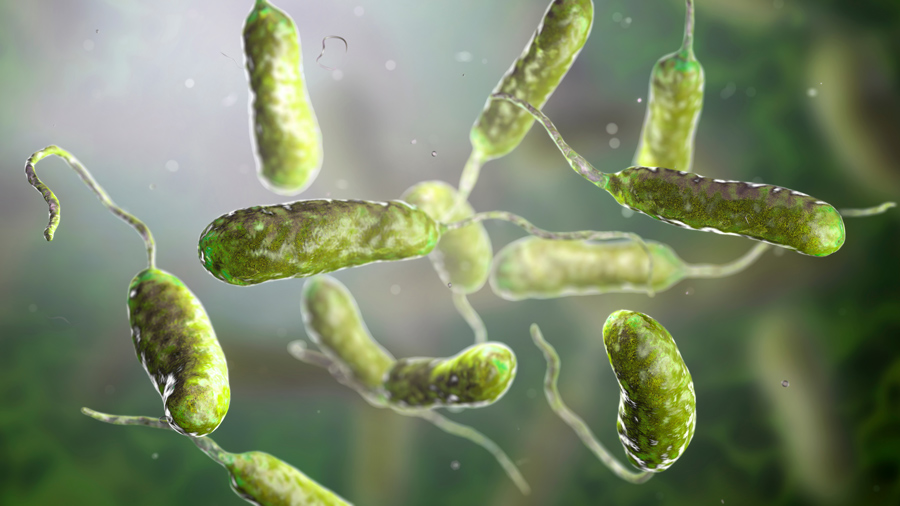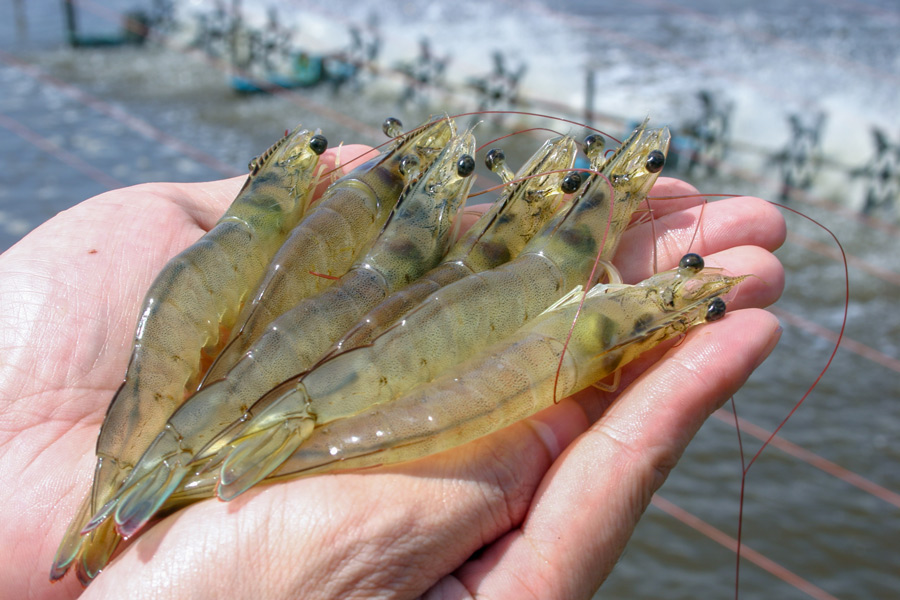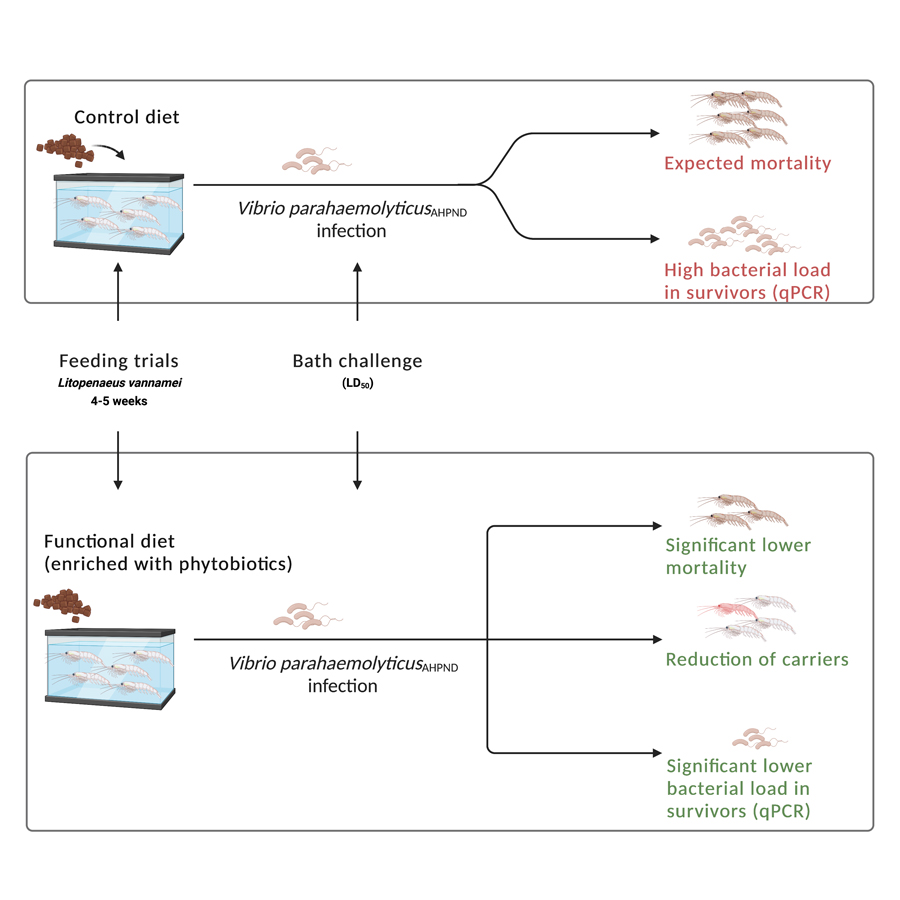Challenging shrimp bacterial diseases with phytobiotics
Whiteleg shrimp, a prized species in aquaculture, faces severe threats from emerging bacterial diseases, with acute hepatopancreatic necrosis (AHPND) posing a significant risk. Traditional reliance on antibiotics to combat this disease, although effective, raises concerns about antibiotic resistance. Dr Carla Hernández-Cabanyero and Dr Belén Fouz of the University of Valencia, Spain, have pioneered a One Health approach, introducing two cutting-edge phytobiotic-supplemented diets. This innovative approach not only holds promise for sustainably mitigating the impact of AHPND but also stands as a compelling step toward reducing antibiotic use.
Whiteleg shrimp (Litopenaeus vannamei) is a highly valuable species in aquaculture. The species accounts for over half of global crustacean production, with culture having grown exponentially over the last few decades. However, infectious bacterial diseases, particularly acute hepatopancreatic necrosis (AHPND), present a significant risk to shrimp aquaculture. AHPND causes economic losses worth billions of dollars as well as public health risks, with concerns regarding the potential for the bacteria to be passed on to consumers.
AHPND is caused by infectious strains of the bacteria Vibrio parahaemolyticus, which contain the pVA1 plasmid, encoding PirA and PirB toxins. These toxins are responsible for the characteristic signs of the diseases, as they lead to cell death by creating pores in the membranes of target cells, promoting damage to the hepatopancreas (an organ with digestive and nutrient storage functions), which results in high mortality rates among infected shrimp.
Current challenges for shrimp bacterial disease
The prevention and management of shrimp bacterial diseases, such as AHPND, is highly important in aquaculture. Typically, the current treatment practice for controlling them is based on antibiotic therapy, as vaccines are not a suitable option due to invertebrates having a primitive immune system. However, because of increasing concerns about the risks related to the emergence of antibiotic-resistant bacteria, alternative strategies that stimulate the shrimps’ innate immune response are crucially needed. Moreover, regulations regarding the use of antibiotics are becoming more restrictive to address this growing public health concern.

In addition, climate change presents a real challenge to aquaculture, including rising ocean temperatures, ocean acidification, and changes in precipitation patterns. While these have significant impacts on marine ecosystems, they also affect shrimp farming, causing stress to the shrimp and disrupting their health, ultimately contributing to an increase in their vulnerability.
To address these issues, it has become necessary to find safer, cost-effective, and sustainable alternatives to antibiotics for the control of bacterial diseases. One strategy is to incorporate immunostimulants into the diet to support the shrimps’ gut health and improve their resistance to bacterial diseases (such as AHPND).
Phytobiotics as an alternative for antibiotics
Phytobiotics are plant extracts that contain safe immune-stimulating compounds. They offer a viable solution for the current challenges and have garnered much attention in recent years.
The prevention and management of shrimp bacterial diseases like AHPND is highly important in aquaculture.These compounds are highly biodegradable, thus environmentally friendly. In addition, as they contain a wide range of bioactive molecules, rather than molecules with a single specific cellular target, they have a reduced likelihood of contributing to the emergence of resistant bacteria.
One Health approach
In an effort to manage AHPND sustainably, Dr Carla Hernández-Cabanyero and Dr Belén Fouz from the University of Valencia (Spain), and colleagues, formulated novel shrimp diets, supplemented with phytobiotics. The researchers evaluated two phytobiotic additives in the form of microencapsulated mixtures of essential oils from thyme and cinnamon, and from oregano and cloves. They prepared functional diets supplemented with these additives to determine whether they were effective against AHPND compared to a non-supplemented control diet, with groups of shrimps being fed one of these diets for 4 to 5 weeks. The shrimps were then exposed to an infectious strain of V parahaemolyticus and the mortality rates were measured.

After exposure to the pathogen, the shrimps that received a diet supplemented with essential oils from thyme and cinnamon showed much lower mortality rates compared to shrimp fed diets that were not supplemented. These promising results suggest that phytobiotics offer benefits to shrimp health regarding the animals’ ability to respond to challenge with bacterial disease.
The researchers also assessed the percentage of V parahaemolyticus carriers and the bacterial load in the hepatopancreas of the surviving shrimp. They found that groups fed for 4 weeks on functional diets supplemented with essential oils had a lower percentage of animals carrying the bacteria. Once again, the diet supplemented with essential oils from thyme and cinnamon showed the best results, with the lowest percentage of carriers.
The findings show that diets supplemented with phytobiotics derived from essential oils from thyme and cinnamon offer potential in protecting shrimp against AHPND and probably also against other shrimp bacterial diseases. Based on their results, this additive has proven to be a good candidate for addressing the impacts of AHPND in shrimp aquaculture in a safe, environmentally friendly, and cost-effective way.
Future implications
The researchers’ findings show that phytobiotic-supplemented feeds in shrimp aquaculture offer a promising solution for controlling bacterial shrimp disease without relying on antibiotic treatments. As AHPND and other bacterial diseases continue to pose a threat to shrimp aquaculture, functional diets utilising phytobiotics present a cost-effective and easily manageable strategy for minimising the impacts of these diseases, while also addressing increasing concerns regarding the emergence of antibiotic-resistant bacteria.
Phytobiotic-supplemented feeds in shrimp aquaculture offer a promising solution for controlling bacterial shrimp diseases without relying on antibiotic treatments.Moreover, by considering both animal and public health risks associated with bacterial diseases in shrimp aquaculture, this solution contributes to the One Health perspective, an approach that seeks to better address health threats within the interface between humans, animals, and the environment.

In future applications in aquaculture, the administration of functional diets supplemented with phytobiotics could be particularly beneficial during critical periods, such as after shrimp are introduced to new rearing tanks or before stressful events, times at which the animals are more susceptible to disease. This would minimise the impacts of AHPND and other diseases and reduce mortalities associated with these periods, thus reducing the economic losses to the shrimp farming industry caused by bacterial diseases.
The researchers’ strategy is also in line with current principles regarding sustainable, environmentally friendly, and economically viable aquaculture practices. Moreover, the use of phytobiotics in feed for shrimp aquaculture aligns with several United Nations Sustainable Development Goals that address the impacts of climate change, including Goal 3 related to good health and wellbeing, Goal 12 related to responsible consumption and production, and Goal 14 related to life below water. As such, phytobiotic-supplemented feeds represent an effective strategy for addressing the current challenges related to bacterial diseases in shrimp aquaculture.
Personal Response
How would you like to see your research applied in practice?We envision our research as a transformative, sustainable solution for controlling bacterial diseases, particularly AHPND, in shrimp culture, but also potentially transferable to other diseases relevant in aquaculture. Phytobiotics, like thyme and cinnamon essential oils, as additives in aquaculture diets, will improve health and reduce mortality due to bacterial pathogens. By replacing antibiotics with phytobiotics, we address antibiotic resistance concerns, aligning with sustainable aquaculture practices. Strategic implementation of diets supplemented with phytobiotics, during vulnerable periods for species relevant in aquaculture, will also help to minimise economic losses.